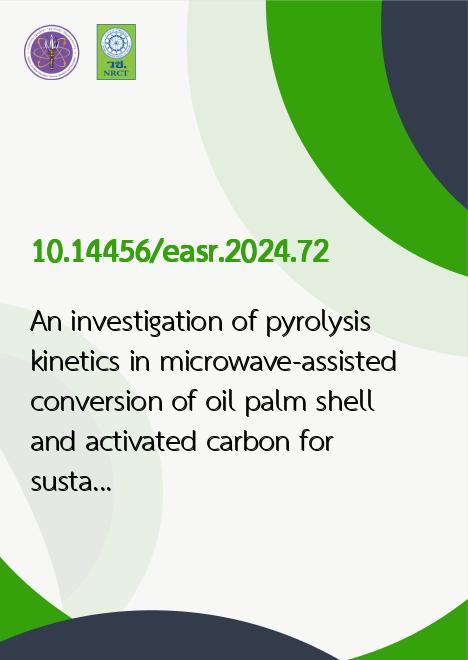
|
An investigation of pyrolysis kinetics in microwave-assisted conversion of oil palm shell and activated carbon for sustainable bio-oil production |
|---|---|
| รหัสดีโอไอ | |
| Creator | 1. Saysunee Jumrat 2. Teerasak Punvichai 3. Wichuta Sae-jie 4. Watsana Boonsawaeng 5. Saranyoo Klaiklay 6. Jirapond Muangprathub 7. Seppo Karrila 8. Yutthapong Pianoroj |
| Title | An investigation of pyrolysis kinetics in microwave-assisted conversion of oil palm shell and activated carbon for sustainable bio-oil production |
| Publisher | Faculty of Engineering, Khon Kaen University |
| Publication Year | 2567 |
| Journal Title | Engineering and Applied Science Research |
| Journal Vol. | 51 |
| Journal No. | 6 |
| Page no. | 764-771 |
| Keyword | Microwave pyrolysis, Pyrolysis kinetics, Oil palm shell, Activated carbon, Bio-oil production |
| URL Website | https://ph01.tci-thaijo.org/index.php/easr/index |
| Website title | Engineering and Applied Science Research |
| ISSN | 2539-6161 |
| Abstract | This study explores microwave (MW) pyrolysis of oil palm shell (OPS) blended with activated carbon (AC) to produce bio-oil, focusing on the pyrolysis kinetics and the effect of different feedstock ratios. Three OPS mixtures (70:30, 75:25, and 80:20) were analyzed at a constant temperature of 400°C. Gas chromatography-mass spectrometry (GC-MS) revealed that acetic acid, phenol, and other oxygenated compounds were dominant in the resulting bio-oils. Pyrolysis kinetics were modeled using a first-order reaction approach, with rate constants and activation energies determined for each blend. The 75:25 ratio yielded the highest bio-oil content and exhibited the most favorable kinetic performance, showing strong alignment between experimental and simulated data (R² = 0.758). The study also examined the impact of pyrolysis temperatures (400°C, 500°C, and 600°C) at the fixed 75:25 ratio, demonstrating that temperature plays a key role in both enhancing bio-oil yield and altering its chemical composition. |